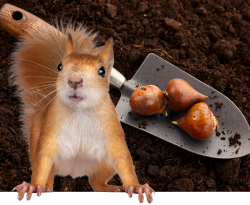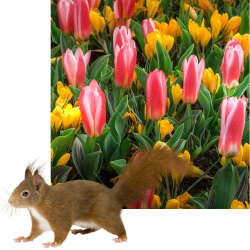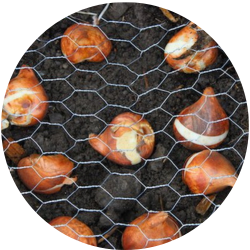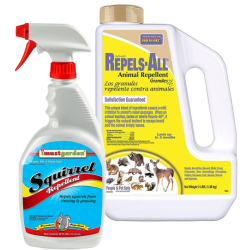
Are you planting a bulb buffet for squirrels each autumn? It can be frustrating to go through the work of planting all those beautiful flower bulbs only to discover them dug up and chewed a few days later.
Take heart! Many a gardener has had this experience, and a few have come up with some creative ways to solve the problem. Armed with these tips, you’ll be well on your way to a squirrel-proof spring garden. Let’s dive in!
Delay Your Planting Schedule
The problem is bulb planting season coincides with squirrels-fattening-up-for-winter season, and that leads to hungry squirrels eating freshly planted flower bulbs! One solution can be to delay your planting time. The height of their feeding frenzy typically peaks in early fall, but it begins to wane by late October. By then, squirrels have already fattened up sufficiently and stored up their winter supplies.
In Colorado, it’s generally a good idea to wait until the weather cools in October before planting spring-flowering bulbs anyway. You can always purchase your bulbs when they first hit the garden center shelves in September, then keep them stored until the weather cools enough to safely put them in the ground.
Add Something They Don’t Like
Are tulips and crocuses your favorite spring flowers? They’re a squirrel’s favorite too! To give your tulips & crocuses a fighting chance, try mixing in a few bulbs that will make squirrels turn up their noses and look for better smelling food elsewhere.

Try adding Allium bulbs to your spring display. Squirrels have an aversion to the scent of this member of the onion family! Planting these ornamental onions among your vulnerable spring bulbs can act as a natural deterrent. Try intermingling Allium with your tulips, crocuses, and other spring favorites. This not only adds an interesting floral visual element, but also helps shield your more delicate blooms.

Create a Protective Barrier
Before planting your bulbs, consider laying down a layer of chicken wire over the soil. This mesh barrier will deter squirrels from digging while still allowing your bulbs to grow through.
Make sure to firmly secure the edges of the chicken wire to prevent any curious critters from lifting it. This extra step ensures your bulbs stay safe and sound. Then cover the wire barrier and the bulbs with soil. The wire will make it difficult for squirrels to dig and encourage them to look elsewhere for an easier meal.
Try Squirrel Repellents
There are several natural substances that squirrels find unappetizing. You can sprinkle crushed red pepper flakes, cayenne pepper, or a garlic-based repellent around your bulb beds.

There are also several ready-to-use squirrel repellents that use all-natural ingredients that you can try. They also repel through strong smells like cedarwood and garlic. Be persistent with all of these, as they’ll need to be reapplied after rain.
Conceal with Mulch Magic
Applying a generous layer of mulch over your bulb beds serves two purposes. Firstly, it helps regulate soil temperature and moisture levels, creating an ideal environment for bulb growth. Secondly, it conceals the scent of the bulbs from prying squirrel noses! Choose Wisely: opt for a heavier mulch like wood chips or bark, which are more difficult for squirrels to move aside.
Remember, persistence is key when it comes to outsmarting hungry squirrels! By combining these tactics, you can create a more formidable defense against these crafty critters and ensure your spring flowering bulbs dazzle with lots of vibrant blooms.
